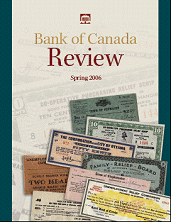Spring 2006

|
Global Imbalances—Just How Dangerous? by Bruce Little and Robert Lafrance
Issues in Inflation Targeting: A Summary of the Bank of Canada Conference Held 28-29 April 2005
Trends in Retail Payments and Insights from Public Survey Results
The Evolution of the Government of Canada's Debt Distribution Framework
See also: Tables A1, A2, and Notes to the Tables Full Review (PDF, 826 kb) |
Cover: Depression Scrip
David Bergeron, Curator, Currency Museum
The Great Depression was a dark period in Canadian economic history. While theories on what caused it vary, historians largely agree that the stock market crash of October 1929 (known as Black Tuesday) was the trigger that sent most world economies into a tailspin. Canada, in particular, was hit hard, with deflation, depreciated markets, and rising unemployment. Not until the outbreak of World War II did the Canadian economy begin to make a full recovery.
Falling commodity prices during the Depression led to deflation, so that consumer prices tumbled and unemployment rose. By 1933, more than one-third of Canada’s labour force were out of work, and one-fifth of the population were dependent on government assistance. Incomes fell by almost half, and prices fell so sharply that the production of currency was affected. The mintage of high-denomination coins at the Royal Canadian Mint was significantly reduced, as was the printing of government and chartered bank notes.
While many private and charitable agencies came to the assistance of the unemployed, much of the financial help was supplied by local municipal governments. Municipalities across Canada issued scrip—redeemable notes that the unemployed could use to cover the cost of such necessities as food, fuel, clothing, housing, and taxes. Many notes were redeemable in specific goods, or as a credit towards the purchase of goods. The various examples of Depression scrip pictured on the cover of this issue reflect the range of goods and services that could be purchased with them, as well as the relatively low value that these pieces of paper represented, from a few cents to a couple of dollars.
Municipalities set up programs where the unemployed received scrip in return for work on municipal projects, with the aim of providing the recipients with a degree of pride and self-respect. Although the system was beneficial for the unemployed, it nevertheless posed a problem for the municipalities, which still had to cover their own expenses. Some responded by issuing scrip specifically intended to pay municipal taxes and other government services, such as water.
Scrip was used for only a short time during the Great Depression. Because of the stigma associated with it, which served as a stark reminder of the suffering that many Canadians faced in the 1930s, much of the Depression scrip was destroyed after its use. Today, many pieces are quite rare and are found only in institutional collections.
The examples of Depression scrip illustrated here are part of the National Currency Collection of the Bank of Canada.




